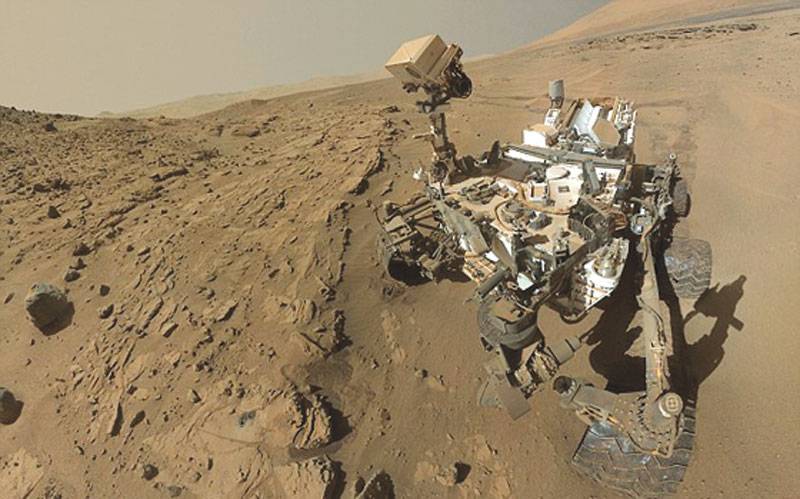MOL Washington - It was a year of historic missions tinged with sadness at tragic accidents in the world of apce.
Nasa today revealed it's highlights of the year from its missions, ranging from the first test of the Orion capsule that will one day take man to Mars to the planet spotting-telescopes that found an 'earth twin'. The space agency said it took 'significant steps' to Mars' - and pledged to get man there as soon as possible.
'In 2014, Nasa took significant steps on the agency's journey to Mars, testing cutting-edge technologies and making scientific discoveries while studying our changing Earth and the infinite universe as the agency made progress on the next generation of air travel,' the agency said.
Nasa Administrator Charles Bolden said the agency was now focused on Mars. 'We continued to make great progress on our journey to Mars this year, awarding contracts to American companies who will return human space flight launches to U.S. soil, advancing space technology development; and successfully completing the first flight of Orion, the next deep space spacecraft in which our astronauts will travel,'
'We moved forward on our work to create quieter, greener airplanes and develop technologies to make air travel more efficient; and we advanced our study of our changing home planet, Earth, while increasing our understanding of others in our solar system and beyond.' The agency also listed its top achievements for the year:
The Journey to Mars
NASA achieved a major milestone in December on its journey to Mars as the agency's Orion spacecraft completed its first voyage to space during a four-and-a-half-hour flight test.
Orion is part of NASA's plan to develop new technologies and capabilities to send astronauts farther than ever before, first to an asteroid, and onward to the Red Planet. Science, technology, engineering and math (STEM)-related education soared to new heights with a student-built radiation experiment aboard Orion.
NASA's Office of Education, partnered with the Lockheed Martin Corp., used the Exploration Design Challenge to engage students in STEM by inviting them to help tackle one of the most significant dangers of human space flight - radiation exposure.
NASA's parallel path for human spaceflight also took a giant leap forward in September when the agency announced US astronauts once again would travel to and from the International Space Station (ISS) from the United States on American spacecraft under groundbreaking contracts worked by Nasa's Commercial Crew Program.
The agency selected Boeing and SpaceX to transport US crews to and from the space station using their CST-100 and Crew Dragon spacecraft, respectively, with a goal of ending the nation's sole reliance on Russia in 2017. NASA's parallel path for human spaceflight involves U.S. commercial companies providing access to low-Earth orbit while NASA prepares deep space exploration missions with Orion and the Space Launch System (SLS) rocket.
The SLS rocket, the most powerful ever built, moved from the concept phase to the development phase in 2014. Also this year, all major tools were installed at NASA's Michoud Assembly Facility in New Orleans where the rocket will be constructed.
For 40 years, increasingly advanced robotic explorers have studied the conditions on Mars. This has dramatically increased our scientific knowledge about the planet, as well as helped pave the way for astronauts on the journey to Mars.
In July, NASA announced its Mars Rover 2020, which is based on the successful Curiosity rover. Mars 2020 will carry instruments to conduct unprecedented science and exploration technology investigations on the Red Planet, including help with data for a human mission to Mars. NASA's newest member of its fleet of robotic Red Planet explorers, the Mars Atmosphere and Volatile Evolution (MAVEN), spacecraft successfully entered Mars' orbit Sept. 21, where it is beginning its study of the planet's upper atmosphere as never done before. That extensive fleet of science assets, particularly those orbiting and roving Mars, had front row seats to image and study a once-in-a-lifetime comet flyby of Mars in October.
Friday, April 19, 2024
Nasa reveals highlights of 2014

3:56 PM | March 28, 2024
4:14 PM | March 23, 2024
Minister reviews naan, roti prices
April 19, 2024
ETPB land worth Rs 40b retrieved so far
April 19, 2024
Lahore revamping plan to complete by June 30
April 19, 2024
CCPO reviews security for by-elections, NZ cricket matches
April 19, 2024
A Tense Neighbourhood
April 19, 2024
Dubai Underwater
April 19, 2024
X Debate Continues
April 19, 2024
Hepatitis Challenge
April 18, 2024
IMF Predictions
April 18, 2024
Kite tragedy
April 19, 2024
Discipline dilemma
April 19, 2024
Urgent plea
April 19, 2024
Justice denied
April 18, 2024
AI dilemmas unveiled
April 18, 2024
ePaper - Nawaiwaqt
Advertisement
Nawaiwaqt Group | Copyright © 2024





